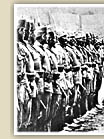|
"Deeply touched I write down today, after sixty years, the shattering events
of the battles of August 1922. I have witnessed them in the battlefields,
so intensely,
|

that remain indelible in my memory, thanks also to the
war diary I used to keep in those days.
The É×a Squadron of Mountain artillery, in which I served, as private,
stationed as reserve with half of its forces near the village
Douger, very close to the name-sake railway station of the line Afyon-Kutahya-Eski
Shehir. On the dawn of 13 August we have been awakened in our tents by the
snaps of the Turkish artillery, hitting the positions of the
V and IV Divisions. You had the feeling that "thunderbolts were thumping
in a severe storm".
[...] In the front of Afyon the Turks were attacking with impetus in succesive waves
under the protection of sweeping fire of 200 light and 62 heavy guns.
In Kamelar and Akar Dag sectors defended by Divisions
IV and É respectively the enemy had captured from the morning the Black Rock to the right
of Division IV and the advanced trenches, the Resistance Centre Tilki Kiri Bel on the sector of Division I.
At the same time the 'Wooded Hilltop' has been captured by the Turks to the left of Division V.
In Kamelar sector its main supports have been the Forked Rock,
the 'Saw-toothed Rock' (alt. 1450) and Koutsouk Kaletzik (alt. 1310), in
Akar sector, Tilki Kiri Bel on the peak of which a wide plateau is formed, Hasan Bel
and Touklou Tepe. Between the two Divisions IV and I there was the
Kagiantibi gap and in the sector of Division I the Tsai Hisar gap. Another vulnerable point
was the deep gorge of Sinir Kioi to the left of the front of Division I, the steep banks of
which facilitated the invisible penetration of the enemy".
Ch. Triantafyllidis, I Mikrasiatiki Ekstrateia kai to Imerologion
enos oplitou, vol. 1, Athens, Dodoni editions, 1984, pp. 551-552.
|
 |
